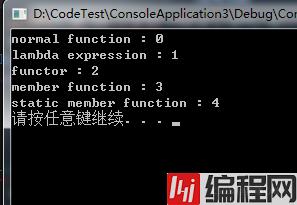目录一、介绍二、实例三、与std::bind的区别总结一、介绍 std::function是函数模板类(是一个类)。包含在#include <functional> 中。
std::function是函数模板类(是一个类)。包含在#include <functional> 中。以前没有这个类的时候,我们在想定义一个回调函数指针,非常的麻烦。我们通常这样的定义:
typedef void(*ptr)(int,int)// 这里的ptr就是一个函数指针而使用了std::function这个类的时候,我们可以这样使用,来替换函数指针。例如:
std::function<void(int ,int)> func;std::function 的实例能存储、复制及调用任何可调用 (Callable) 目标——函数、 lambda 表达式、 bind 表达式或其他函数对象,还有指向成员函数指针和指向数据成员指针。
它也是对 c++ 中现有的可调用实体的一种类型安全的包裹(相对来说,函数指针的调用不是类型安全的)
#include <iOStream>
#include <vector>
#include <list>
#include <map>
#include <set>
#include <string>
#include <alGorithm>
#include <functional>
#include <memory>
using namespace std;
//声明一个模板
typedef std::function<int(int)> Functional;
//nORMal function
int TestFunc(int a)
{
return a;
}
//lambda expression
auto lambda = [](int a)->int{return a;};
//functor仿函数
class Functor
{
public:
int operator() (int a)
{
return a;
}
};
//类的成员函数和类的静态成员函数
class CTest
{
public:
int Func(int a)
{
return a;
}
static int SFunc(int a)
{
return a;
}
};
int main(int arGC, char* argv[])
{
//封装普通函数
Functional obj = TestFunc;
int res = obj(0);
cout << "normal function : " << res << endl;
//封装lambda表达式
obj = lambda;
res = obj(1);
cout << "lambda expression : " << res << endl;
//封装仿函数
Functor functorObj;
obj = functorObj;
res = obj(2);
cout << "functor : " << res << endl;
//封装类的成员函数和static成员函数
CTest t;
obj = std::bind(&CTest::Func, &t, std::placeholders::_1);
res = obj(3);
cout << "member function : " << res << endl;
obj = CTest::SFunc;
res = obj(4);
cout << "static member function : " << res << endl;
return 0;
} 运行结果

可将std::bind函数看作一个通用的函数适配器,它接受一个可调用对象,生成一个新的可调用对象来“适应”原对象的参数列表。
std::bind将可调用对象与其参数一起进行绑定,绑定后的结果可以使用std::function保存。std::bind主要有以下两个作用:
double my_divide(double x, double y) { return x / y; };
int main(int argc, char* argv[])
{
auto fn_half = std::bind(my_divide, std::placeholders::_1, 2);
std::cout << fn_half(10) << '\n'; // 输出为5
return 0;
}参考:
C++ std::function的用法详解
C++11 中的std::function和std::bind详解
本篇文章就到这里了,希望能够给你带来帮助,也希望您能够多多关注编程网的更多内容!
--结束END--
本文标题: C++ std::function详解
本文链接: https://lsjlt.com/news/137719.html(转载时请注明来源链接)
有问题或投稿请发送至: 邮箱/279061341@qq.com QQ/279061341
2024-03-01
2024-03-01
2024-02-29
2024-02-29
2024-02-29
2024-02-29
2024-02-29
2024-02-29
2024-02-29
2024-02-29
回答
回答
回答
回答
回答
回答
回答
回答
回答
回答
0